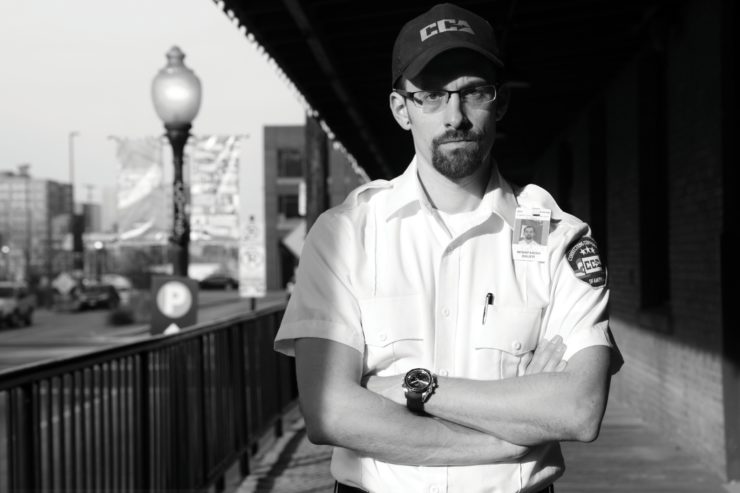
Shane Bauer in his guard uniform.
The American Society of Magazine Editors held its annual Ellies awards gala today, and it was a big night for Mother Jones and The New York Times Magazine.
Here’s a handy list of some of the winners:
Magazine of the Year: Mother Jones.
Reporting: Mother Jones for Shane Bauer’s “My Four Months as a Private Prison Guard.” Storyboard contributor Davis Harper did a great “Notable Narrative” essay and Q&A with Bauer for this monumental story, and you can read it here. Here’s a taste of that post, which has a lot of cool “how I got the story” details:
When did you know that you had a really amazing story on your hands?
I think right when I started. Once I was inside. I didn’t know how long it was going to last, and I still thought it could end at any moment. Even after two days of training, I thought I had a magazine story. I had enough for a magazine story after two days. Once I had been there for a while, it was clear it had to be a huge story. There was just so much that was happening that I saw, that the story couldn’t be without. I think my editors realized that right away as well. There was never even a stated time limit, because they understood this was going to be a huge story. They knew this was a once-in-a-lifetime opportunity. After a week or two, I remember emailing them and saying this is one of the most important stories I’ll ever do in my life. There was a feeling that each and every day, I was getting material that could be a story in and of itself.
Feature writing: The New York Times Magazine for Jennifer Percy’s “I Have No Choice but to Keep Looking.” About a man still searching for the remains of his wife and daughter five years after Japan’s devastating tsunami, it’s a story about loss, but also about obsession, and being trapped in a moment. Beautiful. (It got a shoutout in my weekly column here.) Here’s a taste of it:
We often think of searching as a kind of movement, a forward motion through time, but maybe it can also be the opposite, a suspension of time and memory. Heidegger wrote of a metaphoric pain, calling it the “joining of the rift.” It’s this rift, he said, that holds together things that have been torn apart, to perhaps create a new space where joy and sadness can find communion. This is the space I believed Takamatsu found beneath the sea, where he could feel close to his wife, in the rift between “missing” and “deceased.”
Public Interest: The New York Times Magazine for Nikole Hannah-Jones’ “Choosing a School for My Daughter in a Segregated City.” Here she writes about her childhood, and how it shaped her life, and her decision-making:
It’s hard to say where any one person would have ended up if a single circumstance were different; our life trajectories are shaped by so many external and internal factors. But I have no doubt my parents’ decision to pull me out of my segregated neighborhood school made the possibility of my getting from there to here — staff writer for The New York Times Magazine — more likely. Integration was transformative for my husband and me. Yet the idea of placing our daughter in one of the small number of integrated schools troubled me. These schools are disproportionately white and serve the middle and upper middle classes, with a smattering of poor black and Latino students to create “diversity.”
Essays and Criticism: The New York Times Magazine for Sam Anderson’s “David’s Ankles: How Imperfections Could Bring Down the World’s Most Perfect Statue.” Here’s the great lede:
Last summer, early in the morning, I stood out in the main square of Florence to watch the tourists come in. It was quiet. A Zamboni-like street cleaner drove its rounds, leaving wet circles on the paving stones. A vendor unpacked tarp-wrapped souvenirs from the back of his white van. When the crowds began to arrive — tour groups from Japan, China, Germany, Spain — they seemed less like people than like weather. They surged into the square, pooling and drifting. They clicked selfies in front of the statues. A small herd of Segways rolled past, one rider singing fake opera at the top of his lungs. I watched a tour group from Arizona (clearly identifiable by their neck badges) approach the white figure of Michelangelo’s David, towering on a pedestal in front of City Hall. One of the tourists pointed to it and said, in a tone of amused contempt: “It’s the most famous statue in the world, and they just leave it outside. No big deal — just hose off the pigeon crap.”
Photography: The California Sunday Magazine. We’ve spotlighted this magazine a lot in the past year, and not just because I came to Storyboard from California. It’s doing standout work, both in its photography and its reporting. Here are a couple of the stories we’ve featured on Storyboard in recent months:
Annotation Tuesday! Ashley Powers and “The Man in the Woods”


